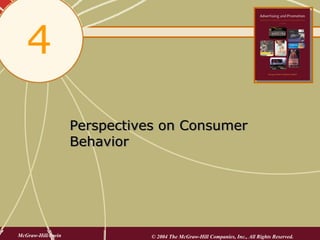
Chap04 Perspectives On Consumer Behavior
- 1. 4 Perspectives on Consumer Behavior McGraw-Hill/Irwin © 2004 The McGraw-Hill Companies, Inc., All Rights Reserved.
- 2. Consumer Behavior The process and activities people engage in when searching for, selecting, purchasing, using, evaluating, and disposing of products and services so as to satisfy their needs and wants.
- 3. The Consumer Decision Process Problem Recognition Problem Recognition Information Search Information Search Alternative Evaluation Alternative Evaluation Purchase Decision Purchase Decision Postpurchase Evaluation Postpurchase Evaluation
- 4. Consumer Decision Process and Relevant Internal Psychological Processes Decision Process Stages Psychological Processes Problem Recognition Problem Recognition Motivation Motivation Information Search Information Search Perception Perception Alternative Evaluation Alternative Evaluation Attitude Formation Attitude Formation Purchase Decision Purchase Decision Integration Integration Postpurchase Evaluation Postpurchase Evaluation Learning Learning
- 5. Sources of Problem Recognition Out of stock Dissatisfaction New needs or wants Related product purchase Market-induced recognition New products
- 6. Maslow’s Hierarchy of Needs Self-actualization needs (self-development, realization) Esteem needs (self-esteem, recognition, status) Social needs (sense of belonging, love) Safety needs (security, protection) Physiological needs (hunger, thirst)
- 7. Pampers appeals to needs for love and belonging in this ad
- 8. Probing the Minds of Consumers Psychoanalytic Theory & Motivation Research In-Depth Interviews The consumer talks freely in an unstructured interview to obtain insights into his or her motives, ideas or opinions. Projective Techniques Methods allowing consumers to project values, motives, attitudes or needs on some external object. Association Tests Consumers respond with the first thing that comes to mind when presented with some verbal or pictorial stimulus. Focus Groups A group of consumers with similar backgrounds or interests discuss a product, idea or issue.
- 9. Information Search Internal Search– information stored in memory External Search – actively seeking information from various sources • Personal sources – Friends, relatives, co-workers • Market-controlled sources – Ads, salespeople, in-store displays • Public sources – Print articles, news reports • Personal experience – Handling, examining, testing, using
- 10. Perception The process by which an individual receives, selects, organizes and interprets information Stages in the perception process: Sensation Attending to information Interpreting information Responding to information
- 11. The Selective Perception Process Selective Exposure Selective Attention Selective Comprehension Selective Retention
- 12. Evaluation of Alternatives All available brands Brand A Brand B Brand C Brand D Brand E Brand F Brand G Brand H Brand I Brand J Brand K Brand L Brand M Brand N Brand O Evoked Set of Brands Brand B Brand E Brand F Brand I Brand M
- 13. Evaluative Criteria Criteria - Dimensions or attributes of a product or service used to compare various alternatives Objective criteria - price, warranty, color, size Subjective criteria - style, appearance, image Consequences – outcomes that result from using a product or service Functional consequences – concrete and tangible Pyschosocial consequences – abstract, intangible
- 14. This ad focuses on the favorable consequences of using Top Flite golf balls
- 15. Consumer Attitudes Learned predispositions to respond toward an object—an individual’s overall feelings toward or evaluation of an object. Consumers may hold attitudes toward: • Individuals • Brands • Companies • Organizations • Product categories • Retailers • Advertisements • Media
- 16. Multiattribute Attitude Model Attitudes are a function of: A = Σ Bi X Ei A = Attitude Bi = Beliefs about brands performance on attribute i Ei = Importance attached to attribute i N = Number of salient attributes considered by consumer
- 17. Ways to Influence or Change Attitudes Increase or change the strength or belief rating of a brand on an important attribute Change consumers’ perceptions of the importance or value of an attribute Add a new attribute to the attitude formation process Change perceptions of belief ratings for a competing brand
- 18. Integration Processes and Decision Rules Integration processes are the way product knowledge, meaning, and beliefs are combined to evaluate alternatives Types of decision rules: • Heuristics – simple rule of thumb rules that are easy to use and apply – Buy least expensive brand – Buy brand on sale or for which I have a coupon • Affect referral rule – make decision on basis of overall affective impression or feelings about the brand • Compensatory rules – evaluate the strengths and weaknesses of each brand
- 19. Market leaders such as Budweiser appeal to consumer affect in their advertising
- 20. Consumer Learning Processes • Cognitive Learning – Consumers learn through information processing and problem solving • Behavioral Learning – Learning via association (classical conditioning) – Learning via reinforcement (instrumental cond.) • Modeling Processes – Based on observation of outcomes and consequences experienced by others
- 21. Cognitive Learning Process Goal Purposive behavior Insight Goal achievement
- 22. Classical Conditioning Process Unconditioned Unconditioned Unconditioned Unconditioned stimulus stimulus response response (waterfall) (waterfall) (freshness, purity) (freshness, purity) Association develops through contiguity and repetition Conditioned Conditioned stimulus Conditioned Conditioned stimulus response (Brita water (Brita water response (freshness, purity) (freshness, purity) filtration pitcher) filtration pitcher)
- 23. This Brita ad uses classical conditioning
- 24. Instrumental Conditioning Process Behavior Behavior Positive or negative Positive or negative (consumer uses (consumer uses consequences occur consequences occur product or service) product or service) (reward or punishment) (reward or punishment) Increase or decrease in Increase or decrease in probability of repeat probability of repeat behavior (purchase) behavior (purchase)
- 25. External Influences on Consumers Culture Subculture Social class Reference groups Situations
- 26. The Hispanic subculture is a very important market in many parts of the U.S.
- 27. Variations in Consumer Decision Making Types of Decision Processes: • Extended Problem Solving • Limited Problem Solving • Routine Response Behavior
- 28. IMC Communications Task Grid Decision Communication Target Where and IMC Options Role Task Audience When Role in Desired result or Primary Best way to Best IMC tool Decision effect from group to reach reach at each to accomplish Marking communication at each stage stage communication Process task Initiator Influencer Decider Purchaser User
